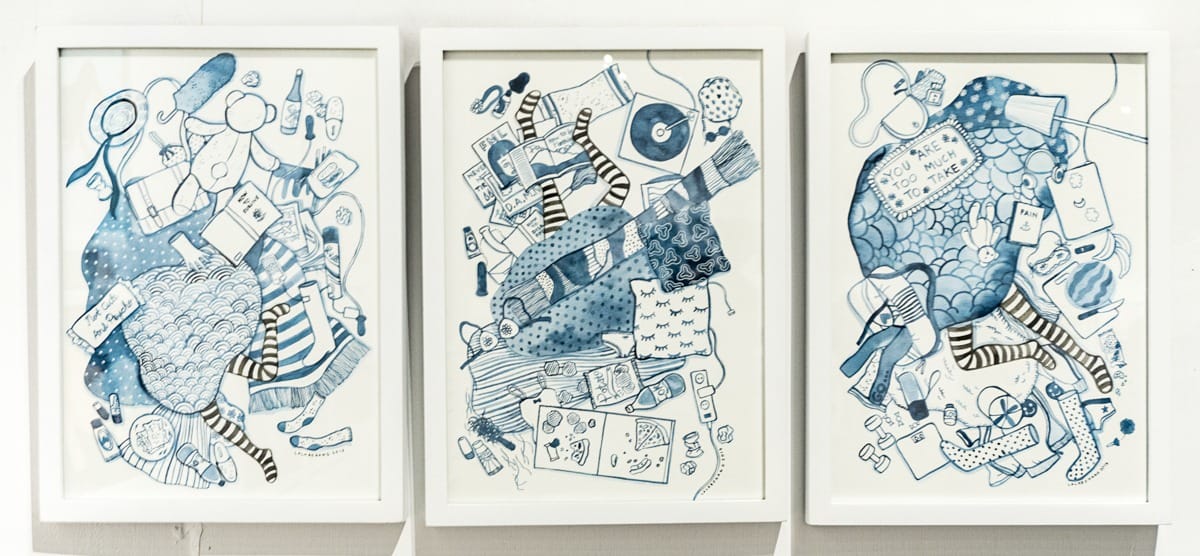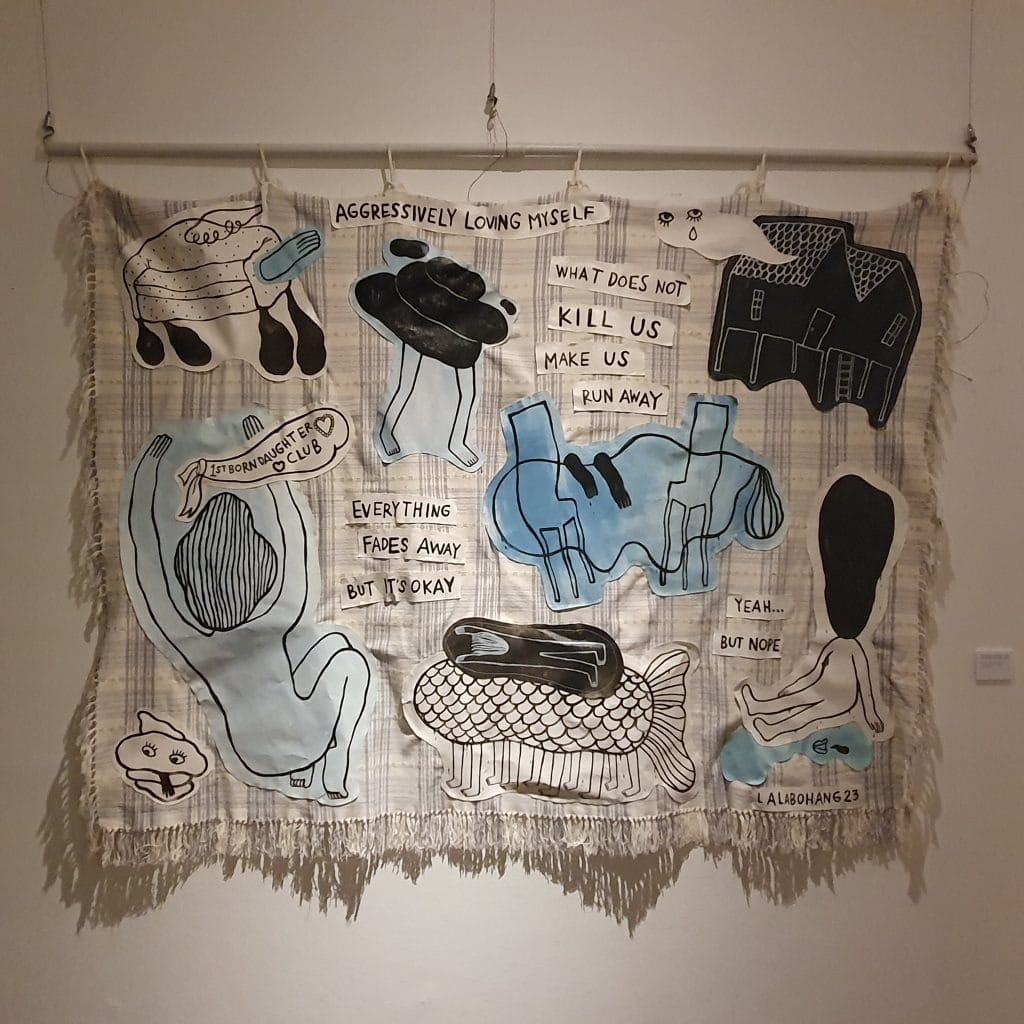We experience life in a multitude of ways. Even though we might not be the main character in another person’s story, we are still the main characters, as well as the director, screenwriter, and producer of our own. Lala Bohang explores this concept in her book, In The Middle of Everything, recounting moments within life where, as the main protagonist of one’s own experience, experience becomes incremental to life’s specific outcomes. Bohang also explores the realities of femininity, mental health and existentialism through her textual body of work, encouraging the audience to notice the cultural nuances of the author’s lived experiences. Bohang’s approach to stylistic writing, combined with elements of graphic illustration and poetic prose, gives the audience a unique window into the emotional aspects of womanhood within Southeast Asian cultures. Bohang’s honest recollection of the desire to appease all sides of one’s desires, from pleasing the family to pleasing oneself, has led to questioning one’s purpose in existence. From the desire to fit in to the desire to pursue individuality, the concepts Bohang presents in her works relate to the United Nations Sustainable Development Goals of Gender Equality. It is a modern tragedy that the woman’s role in society is predetermined by the societies that host her. Her individuality, and in turn, her lack thereof, is often the product of societal expectations of perfected performance in the act of femininity.
“A woman has to always be patient and endure hardships; you have to understand that love means to be in control,” Bohang writes in her poetic prose. The complexities of feminine performance have historically developed as a means to suppress women's desires to be more than mere servants. As Bohang reflects in her book, many communities teach across generations that a woman’s desire for the unknown must be suppressed to fulfill her duty as a mother and a wife.
The reality is, womanhood, especially within hyper-religious Southeast Asian societies, can be uncomfortable and complex due to the intricacies of the intermingled web of societal values and religious values. Marginalization and sexualisation are often rampant within Southeast Asian nations. As Dr. Phil. Syafiq Hasyim writes,
“The lack of proper understanding on the discourse and practice of gender in Indonesia is a result of complex intermingling between social, cultural and legal factors on the one hand and male-biased interpretation of religion on the other hand."

“We pressure ourselves to complete the ‘duty’ without grasping what it means in the first place. We have impossible expectations to be happy despite it being just a spectrum of emotions.” - Lala Bohang, In the Middle of Everything.
The conflict between the feminine performance and religious affinity can become a conflicting plague in the woman’s role in society. You must be sexually desirable, yet pure. You must be independent, yet entirely devoted to your husband. You must age gracefully, but never show signs of such aging. You must not have defiant thoughts, but must have a mind strong enough to raise intelligent children. Many communities within Indonesia often view women as transferable property. As Rahayu Suriati Hidayat concludes, a woman’s role within different native communities in Indonesia depends on her community’s ideologies of women and the religious understandings that follow, leaving much room for improvement in her fight for her own right to be truly free.

Bohang’s reflective writing allows her audience to feel the auteur's abstract thoughts. In the chapter "A Warning Bot," Bohang reflects on aging and the freedom it brings. Bohang reflects on the lack of judgment older people face as they embrace their freedom.
“When death is near, nothing matters anymore. The longing affection to connection will vanish. You no longer have a high-maintenance interior space; it is just you and yourself, the main force of your life and love. It is calm and loving.” Bohang writes. Historically, women are often demonized for allowing themselves to age. Women are frequently disrespected as they age out of their prime. Victoria Smith writes in her book, ‘Hags: The Demonisation of Middle-Aged Women’:
“Beauty, like gender, is relational; women have been obliged to remain forever young so men can delude themselves that they are not ageing themselves.”
Women are rarely told to reflect on aging in relation to freedom, because society as a whole does not allow them to age. In her reflection on aging, Bohang challenges the audience to see it as freeing rather than a curse; a celebration of life rather than a reminder of imminent death.
Bohang’s book also includes darker elements of one’s thoughts: “I have metamorphosed into the monster version of myself, eating myself from the inside,” she writes, showcasing how restrictive expectations of women to perform can lead to internal conflicts between the desire to conform and the desire to be free. Bohang also writes about engaging in high-consumerist activities, such as investing in crypto and eating at the latest trendy restaurants. In “I Was,” Bohang writes about the people who impact the narrator, listing their ages and representing each with a letter of the alphabet to showcase her surroundings and how they affected her mental state. Many chapters also reflect upon the auteur’s childhood trauma and how it has shaped her personality. The book’s playful prose creates a fascinating, humorous yet intricate take on life and its philosophies, showcasing how you are the product of your environment and, despite your role in shaping your story, you are still responsible for the plotline of your life.

Bohang’s exploration of life, humanity, and femininity in her book “In the Middle of Everything” is an honest representation of life and the beauty in one’s experiences. Her exploration of the relationship between the self, relationships, traditions, and femininity through tongue-in-cheek prose creates an engaging read unlike any other book. Bohang’s book reads like a mobile work of art, one that keeps you on your toes and leaves you thinking about the intricacies of life.
